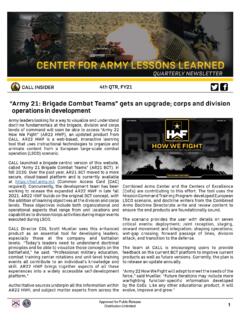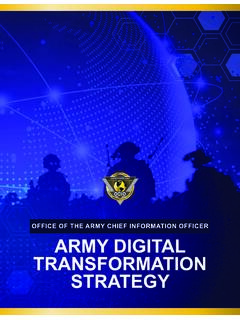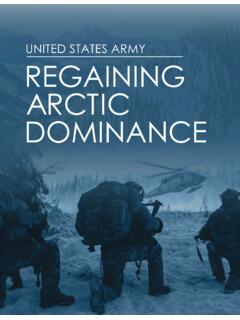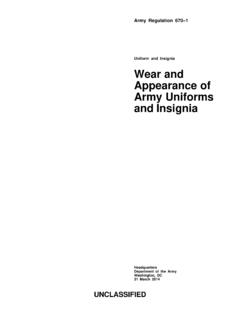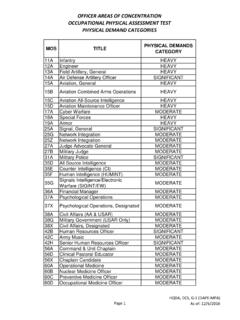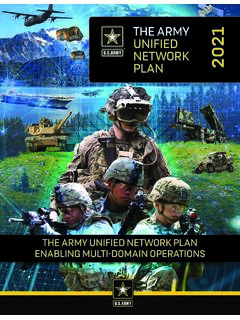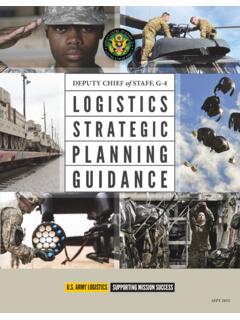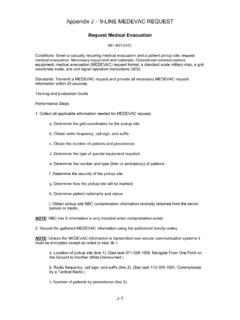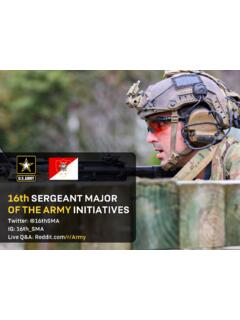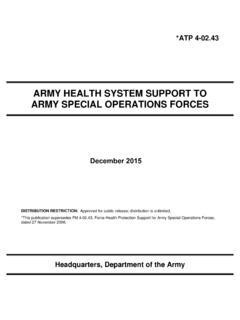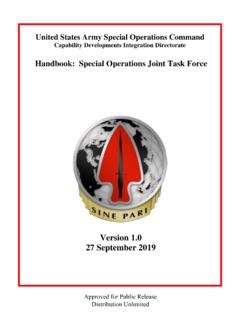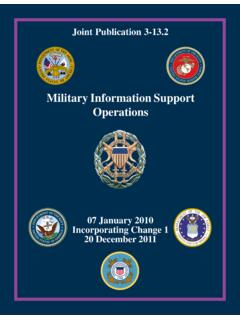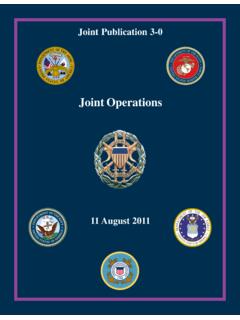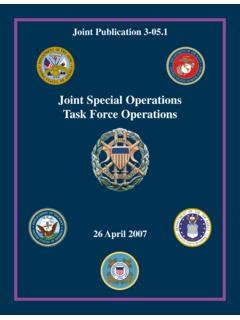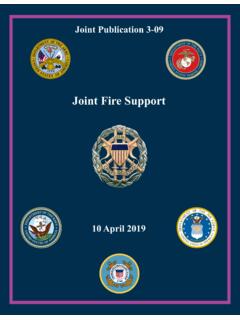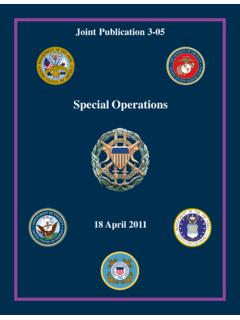Transcription of JP 3-09, Joint Fire Support - United States Army
1 30 June 2010 Joint fire SupportJoint Publication 3-09 i PREFACE 1. Scope This publication provides fundamental principles and guidance for planning, coordinating, and executing Joint fire Support across the range of military operations. 2. Purpose This publication has been prepared under the direction of the Chairman of the Joint Chiefs of Staff. It sets forth Joint doctrine to govern the activities and performance of the Armed Forces of the United States in Joint operations and provides the doctrinal basis for interagency coordination and for US military involvement in multinational operations. It provides military guidance for the exercise of authority by combatant commanders and other Joint force commanders (JFCs) and prescribes Joint doctrine for operations, education, and training.
2 It provides military guidance for use by the Armed Forces in preparing their appropriate plans. It is not the intent of this publication to restrict the authority of the JFC from organizing the force and executing the mission in a manner the JFC deems most appropriate to ensure unity of effort in the accomplishment of the overall objective. 3. Application a. Joint doctrine established in this publication applies to the Joint Staff, commanders of combatant commands, subunified commands, Joint task forces, subordinate components of these commands, and the Services. b. The guidance in this publication is authoritative; as such, this doctrine will be followed except when, in the judgment of the commander, exceptional circumstances dictate otherwise.
3 If conflicts arise between the contents of this publication and the contents of Service publications, this publication will take precedence unless the Chairman of the Joint Chiefs of Staff, normally in coordination with the other members of the Joint Chiefs of Staff, has provided more current and specific guidance. Commanders of forces operating as part of a multinational (alliance or coalition) military command should follow multinational doctrine and procedures ratified by the United States . For doctrine and procedures not ratified by the United States , commanders should evaluate and follow the multinational command s doctrine and procedures, where applicable and consistent with US laws, regulations, and doctrine. For the Chairman of the Joint Chiefs of Staff: LLOYD J.
4 AUSTIN III Lieutenant General, USA Director, Joint Staff Preface ii JP 3-09 Intentionally Blank iii SUMMARY OF CHANGES REVISION OF J OINT PUBLICATION 3-09, DATED 13 NOVEMBER 2006 AND SUPERSESSION OF J OINT PUBLICATION , DATED 28 MAY 1999 Consolidates Joint Publication (JP) , Joint Tactics, Techniques, and Procedures for Laser Designation Operations, into JP 3-09, Joint fire Support , and cancels JP Clarifies what constitutes nonlethal fires and their purpose Expands the discussion of the Joint fires element to explain the key functions and tasks it generally performs Updates the descriptions of the component fires command and control entities provided by the Services; to include new descriptions: forward air controller (air), tactical air controller (air)
5 , Joint forward observer, Joint tactical air controller and Joint air component coordination element Adds paragraphs on the Advance Field Artillery Tactical Data System and Theater Battle Management Core Systems Eliminates detailed discussion on datums, coordinates systems, and area reference systems and references JP 2-03, Geospatial Intelligence Support to Joint Operations, for the source of this information Inserts new Joint fire Support Assessment paragraph Adds an Airspace Coordinating Area subparagraph under Airspace Coordinating Measures paragraph in Appendix A Incorporated the JP material into new Appendix C Modifies the definitions of counterfire, fires, schedule of fire , and supporting fire Creates new term and definition for concept of fires Removes from JP 1-02, Department of Defense Dictionary of Military and Associated Terms, the terms and definitions for.
6 At my command, backscatter, call fire , call for fire , continuous illumination fire , direct Support artillery, enlisted terminal attack controller, fire , fire , barrage (specify), fire capabilities chart, fire control, fire control radar, fire control system, fire coordination, fire for effect, fire message, fire mission, fire plan, firepower, firing chart, laser, laser footprint, laser linescan system, laser pulse duration, laser target designating system, laser-target/gun-target angle, laser target marker, laser Summary of Changes iv JP 3-09 target making system, low angle, low angle fire , low angle loft bombing, offset lasing, pulse code, pulse repetition frequency, rate of fire , special operations terminal attack controler, spillover, and submunition v TABLE OF CONTENTS PAGE EXECUTIVE SUMMARY.
7 Vii CHAPTER I Joint fire Support OVERVIEW Introduction .. I-1 Concept of Fires .. I-2 Employment Considerations .. I-3 Synchronization of Maneuver and Fires .. I-4 Synchronizing and/or Integrating Maneuver and Interdiction .. I-5 CHAPTER II Joint fire Support COMMAND AND CONTROL Introduction .. II-1 Joint fire Support Command and Control .. II-1 CHAPTER III Joint fire Support PLANNING AND EXECUTION Introduction .. III-1 Joint fire Support Planning .. III-1 Other Planning Considerations .. III-4 Joint fire Support Planning Process .. III-7 Joint fire Support Coordination .. III-12 Joint fire Support Assessment .. III-16 Joint fire Support and Force Capabilities .. III-17 Joint fire Support Coordination Measures and Reference Systems.
8 III-20 Combat Identification .. III-20 Mitigation of Collateral Damage .. III-21 APPENDIX A Control and Coordination Measures .. A-1 B Joint fire Support Operation Order Format .. B-1 C Laser-Guided Systems .. C-1 D References .. D-1 E Administrative Instructions .. E-1 Table of Contents vi JP 3-09 GLOSSARY Part I Abbreviations and Acronyms .. GL-1 Part II Terms and Definitions .. GL-6 FIGURE II-1 Typical Joint Fires Element .. II-3 III-1 Joint fire Support Planning Process .. III-8 A-1 fire Support and Control Measures .. A-3 A-2 fire Support Coordination Line .. A-4 A-3 Restrictive fire Line, fire Support Area, and Zone of fire .. A-8 C-1 Airborne and Ground Designator Advantages and Disadvantages ..C-6 C-2 Example of Safety Zone, Acquisition Area, and Optimal Attack Zone ..C-8 C-3 Hellfire Designator Exclusion Zone.
9 C-9 vii EXECUTIVE SUMMARY COMMANDER S OVERVIEW Describes the Joint fire Support System Discusses Joint fire Support Command and Control Delineates Joint fire Support Planning and Execution Overview Scope and Purpose This publication provides fundamental principles and guidance for planning, coordinating, and executing Joint fire Support across the range of military operations. It sets forth Joint doctrine to govern the activities and performance of the Armed Forces of the United States in Joint operations and provides the doctrinal basis for interagency coordination and for US military involvement in multinational operations. Introduction Command and Control The foundations of Joint fire Support are based on the elements of combat power, the principles of Joint operations, and Joint functions.
10 The elements of combat power are combined to provide the basis for the generation of overwhelming firepower. The fire Support system has its roots in the firepower element of combat power. Joint fire Support is Synchronized to Collectively Ensure Effective Fires. Synchronized Joint fire Support requires the coordinated interaction of all of the elements of the fire Support system, thorough and continuous planning, aggressive coordination, and vigorous execution. The fire Support system includes the target acquisition, command and control (C2), and attack/delivery systems that must function collectively to ensure effective fires are delivered where and when the commander requires them. Fires Fires. Fires are defined as the use of weapon systems to create a specific lethal or nonlethal effect on a target.
